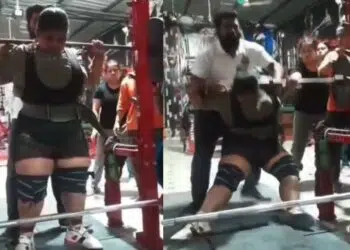A lot of athletes train their neck muscles directly. Wrestlers, football players, MMA fighters, and boxers are probably the most likely to do direct neck training. In sports, a strong neck is an injury-resistant neck.
After all, getting punched in the head in MMA or tackled in football has the potential to cause a lot of neck trauma. Stronger muscles can help protect you from injury. They act as shock absorbers and prevent your head from being jolted quite so violently.
But, in bodybuilding, direct neck training is much rarer.
This wasn’t always the case. In fact, in the golden era of bodybuilding, neck training was much more common, and most lifters included it as part of their upper body workouts. According to the coaches and judges of the day, a bodybuilder’s calf, arm, and neck should all measure the same. So, if you had 17” arms, your neck should be 17” too.

People with skinny necks were often called pencil necks – and that was considered a very derogatory term – like noodle arms or chicken legs would be today.
Level Up Your Fitness: Join our 💪 strong community in Fitness Volt Newsletter. Get daily inspiration, expert-backed workouts, nutrition tips, the latest in strength sports, and the support you need to reach your goals. Subscribe for free!
So, whether you are a bodybuilder or an athlete, direct neck training can add a lot to your physique, making you look more powerful and capable. That same increased neck muscle size and strength could also protect you from injury during contact sports.
Neck Anatomy 101
Before we get into the nitty-gritty of the best exercises for a bigger, more muscular neck, let’s take a quick look at the muscles and joints that make up this often under-trained body part. It’s always useful to know the basic anatomy and physiology of what you are training, so you can choose the best exercises for your goals.
Your neck is made up of seven vertebrae – collectively called your cervical spine. It can perform the following movements:
- Flexion – looking downward
- Extension – looking upward
- Rotation – looking over your shoulder
- Lateral flexion – lowering your ear toward your shoulder
Some of these joint actions can be combined to create additional movements, such as rotation and extension to tilt your head up diagonally.
Your main neck muscles and their primary functions are (1):
Trapezius
You’re probably already familiar with this muscle and may train it as part of your back or shoulder workouts. There are three trapezius muscles: lower, middle, and upper. Lower and middle trapezius do not affect your neck. However, the upper traps originate on the base of your skull and are responsible for the elevation of your shoulder girdle and extension of your neck.
Scalenes
Located on the side of your neck, the primary role of the scalenes is lateral flexion and rotation of your head. There are three scalene muscles: anterior (front), medial (middle), and posterior (rear), and while these muscles have separate origins and insertions, they typically work together to control your cervical spine.
Splenius muscles
This is a group of two muscles: the splenius capitus and the splenius cervices. Their main function is to extend and rotate your neck. They’re located on the back and side of your cervical column.
Levator scapulae
Located on the sides of your neck, the levator scapulae work with the upper traps to elevate your shoulder girdle. However, when you hold your shoulders down, these muscles also play a part in neck rotation.
Sternocleidomastoid
This neck muscle has two heads: the sternal head and the clavicular head. Both heads share an attachment on the temporal bone at the base of the skull. Their main functions are the rotation of your head, as well as flexion of the neck and pulling your head forward.
The Best Exercises for A Thicker, Stronger Neck
Because the neck is such a complex structure, there are a lot of exercises you can do to strengthen and build it. To keep things simple, we’ve categorized the best neck building exercises by their anatomical movement.
Lateral Flexion Exercises:
Lateral flexion means bending your neck sideways and lowering your ear down toward your shoulder. These exercises will help give your neck width when viewed from the front or from the rear.
1. Manual Resistance Isometric Neck Lateral Flexion
This is probably the simplest and most accessible way to work the lateral aspect of your neck. All you need is a towel for comfort and your own arm for resistance.
How to do it:
- Seated or standing, fold a towel and hold it between the palm of your hand and the side of your head.
- Push your head against your hand.
- Hold for 10-30 seconds and then swap sides.
- Do not hold your breath while doing this exercise.
- Perform for the same duration on both sides
2. Manual Resistance Neck Lateral Flexion
Exercise #1 can also be done isotonically instead of isometrically. Use your arm for resistance as before but don’t push quite as hard, allowing your head to flex laterally down toward your shoulder. Raise your head back up and repeat. This exercise should be done for reps rather than a predetermined time.
3. Lying Weighted Lateral Neck Flexion
While manual resistance exercises are straightforward to perform, they’re hard to quantify. After all, how do you know how much resistance you are using? Weighted exercises like this lateral neck flexion movement are easier to progress because you can just add a little more weight. You will, however, need a neck training harness to do it.
Read more about weighted lateral neck flexion.
4. Lateral Neck Bridge
Bridging is a traditional way to build neck strength and size. It uses your body weight for resistance and can be done statically or dynamically. This bridging variation works the side of your neck.
How to do it:
- Stand sideways on to a wall or pillar. Place a pad between the side of your head and the wall/pillar, such as a thick towel or a folded gym mat. You can also use a stability ball.
- Lean against the wall/pillar and support your weight using your neck. The more upright you are, the easier this exercise will be, so move your feet in or out according to your needs.
- You can hold this position to work your neck muscles isometrically or use your muscles dynamically to push your body away from the wall/pillar.
Extension Exercises:
Neck extension primarily uses the muscles on the back of your neck. These muscles are critical for posture because they help hold your head up against the pull of gravity. The following exercises are useful for anyone who spends a lot of time hunched over a keyboard.
Level Up Your Fitness: Join our 💪 strong community in Fitness Volt Newsletter. Get daily inspiration, expert-backed workouts, nutrition tips, the latest in strength sports, and the support you need to reach your goals. Subscribe for free!
1. Harness Neck Extensions
Using a neck harness means you can precisely control how much weight you are lifting. Usually made from webbing and with a loading chain or strap, neck training harnesses are cheap, portable, and light. While some gyms have them, for hygiene reasons, it’s probably best to buy your own. That also means you can train your neck at home.
How to do it:
- Put on your neck harness so that the chains/straps are hanging over the front of your shoulders. Sit or stand as preferred.
- Once you have loaded your harness, lean forward, so your upper body is inclined to about 45 degrees. Support your body weight with your arms if you wish.
- Lower your chin down toward your chest and then lift it up again.
- Take care to control your range of motion and do not hyperextend or hyperflex your neck, both of which could cause injury.
2. Manual Resistance Isometric Neck Extensions
This is an excellent exercise for desk workers. You don’t need any specialist equipment, so you can do it almost anywhere and anytime. Use this exercise to break up long periods of sitting, especially if you tend to look down at your keyboard a lot.
How to do it:
- Loop a towel over the back of your head and then hold the ends with your hands at about eye-level.
- Push your head back into the towel while resisting with your arms.
- Hold for 10-30 seconds and then relax.
- Do not hold your breath while doing this exercise.
3. Stability Ball Neck Bridge
The wrestler’s bridge is a traditional neck and back exercise. However, it’s also quite a dangerous exercise and is unnecessarily risky for most people. It’s probably best not to try the wrestler’s bridge without proper instruction. Even then, the chances of injury are quite high. This variation is much easier to learn and far safer too.
How to do it:
- Sit on your exercise ball. Walk your feet forward and lie back. Roll the ball up toward your shoulders until your head is resting against the ball.
- Walk your feet out a little further so that only your head is touching the ball. Keep your neck straight or slightly extended.
- Hold this position for as long as you can and then roll back onto the ball. Alternatively, roll out and back on the ball and do this exercise for reps instead of time.
4. Manual Resistance Neck Extensions
Exercise #3 can also be done with movement instead of isometrically. Use your arms for resistance as before but don’t pull quite as hard so that you can lower and then raise your head. This exercise should be done for reps and not for a predetermined time.
Flexion Exercises:
Flexion exercises primarily target the muscles at the front of your neck. If you spend a lot of time driving or working at a computer, these muscles may be short and tight and responsible for any forward head posture you have. A forward head carry puts a lot of stress on the muscles at the back of your neck, which is why neck extension exercises are so important.
However, short and tight muscles can still be weak, so use these exercises to strengthen the muscles at the front of your neck.
1. Stability Ball Neck Bridge
While you can perform this exercise on the floor, you’ll find it a whole lot more comfortable if you do it against a wall using a stability ball. If you don’t have access to a stability ball, a folded gym mat or towel will suffice.
How to do it:
- Place the ball against the wall and then lean your forehead against it. Take care not to crush your nose.
- Step back to transfer and support your weight on the front of your neck. The further back you move your feet, the harder this exercise becomes.
- Hold this position for 10-30 seconds.
- You can also do this exercise dynamically by pushing your head forward into the ball and lifting your body using your neck muscles.
2. Supine Head Lifts
Supine means facing the sun, so you perform this exercise lying on your back. You can do it on the floor or, if you want a bigger range of motion, using an exercise bench. It can be done with or without weight as preferred.
How to do it:
- Lie on your back on the floor or an exercise bench. If you are using a bench, position yourself so that your head and neck are unsupported and free to move.
- Lift your head and tuck your chin into your chest. Extend your neck and lower your head as far down as you comfortably can.
- Rest and hold a weight plate on your forehead, wrapped in a towel for comfort, if required. Or, if you are lying on a bench, you could use a neck training harness instead.
3. Manual Resistance Neck Flexion
This is the simplest way to strengthen your neck flexors. It requires no equipment, so you can do it anywhere and anytime. Like most manual resistance exercises, you can do this exercise isometrically or dynamically or using a partner to provide the overload.
How to do it:
- Place one or two hands against your forehead.
- Bracing your arms for resistance, push your head into your hands.
- Either hold your head stationary for an isometric workout or, if you prefer, don’t push quite so hard and allow your head to move.
Rotation Exercises:
While rotation is an entirely natural neck movement, it’s also one that’s quite hard to train. Also, because of the potential shearing force on the cervical vertebrae, it’s a movement pattern that should not be done against significant resistance. That said, if you are a boxer, wrestler, or anyone else whose neck may be forcefully twisted, it’s definitely worth doing some rotational neck exercises.
1. Resistance Band Neck Rotations
This exercise can pull on your skin and hair, and you’ll need a wide theraband-type exercise band to do it. However, it’s probably the best way to train for neck rotation.
How to do it:
- Tie a resistance band around your head and fix the other end to a suitable anchor point. The band should be tight enough so that it won’t slip too much as you turn your head.
- Standing sideways on to the anchor, turn your head and look over your shoulder.
- Slowly return to the starting position and repeat.
- Remember to do the same number of reps on both sides.
2. Manual Resistance Neck Rotations
No band? No problem! You can also do neck rotations using nothing but your own arms for resistance. Alternatively, you can use a partner instead.
How to do it:
- Seated or standing, place the palm of one hand against the side of your face.
- Turn your head toward your hand while resisting with your arm.
- Either hold your head stationary for an isometric workout or, if you prefer, don’t push quite so hard and allow your head to move.
Tips for Safe and Effective Neck Training
Get the most from your neck workouts with these handy tips!
1. Don’t Forget to Warm-up
Of all the joints in the human body, your neck is probably the one you move the least. Most of us keep our heads reasonably stationary and rarely move our cervical spines through anything close to a full range of motion.
Because of this, make sure you warm your neck up properly before training it. Nodding your head up and down ten or more times and turning it from the left to the right will help warm and stretch the area.
You can also roll your head around in a circular motion, but you should do this movement slowly and with control to minimize joint wear and tear.
Also, take care when extending your neck and looking up. This can pinch the blood vessels at the back of your neck and reduce blood flow to your brain, which could lead to dizziness or fainting, especially in older exercisers. This is called cervical vertigo (2).
2. Don’t do Too Much Neck Training Too Soon
If you’ve got a skinny neck, you may be tempted to add lots of neck training to your workouts so you can build these muscles as fast as you can. While your enthusiasm is to be applauded, you should avoid doing too much neck training too soon or going too heavy right off the bat.
Severe post-exercise soreness can be very debilitating, making even turning or nodding your head very painful. In addition, sore and tight neck muscles can cause intense headaches. For these reasons, introduce neck training gradually to your workouts and start light too.
3. Train Your Neck With Care
Avoid potentially serious injury by keeping your movements smooth and controlled and never forcing your neck beyond its comfortable range of motion. The neck is quite a robust and mobile joint, but it won’t take much to injure it.
Neck injuries are notoriously slow to heal. A painful neck could stop you from sleeping and make many of the activities of daily living uncomfortable to perform. Do not train your neck to failure, and if any of these exercises cause joint rather than muscle pain, seek out a more comfortable alternative.
In most cases, the isometric or static exercises are the least likely to cause neck pain. These exercises work your muscles without affecting your joints.
Wrapping Up
If your neck is already thick and strong, you may not even need to train this muscle group. After all, an overdeveloped neck can look almost as bad as an underdeveloped one, and means you’ll probably need to buy custom-made shirts!
But, if you have a pencil neck, or your biceps and calves are significantly bigger than your neck, it may be time to take action. Use these exercises to add a couple of inches to the circumference of your neck. But, take it slow and steady because training your neck too hard or too often can lead to serious short-term pain and even long-term injuries.
References:
1 – PubMed: Non-Invasive Analysis of Human Neck Muscle Function. https://pubmed.ncbi.nlm.nih.gov/8610245/
2 – PubMed: Pathogenesis, Diagnosis, and Treatment of Cervical Vertigo. https://pubmed.ncbi.nlm.nih.gov/26218949/










